On Parrots
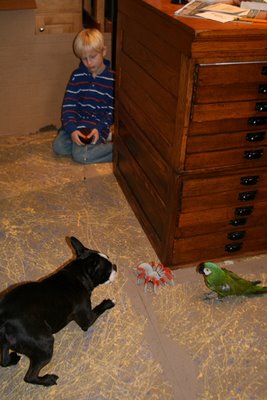
It's interesting to see the differing reactions of Chet Baker and Charlie the chestnut-fronted macaw when confronted with a large remote-controlled tarantula. Charlie, like Chet, is one smart cookie, and in his 20 years he's been faced with a lot of unusual stimuli. I found KatDoc's comment a typically insightful one. Faced with this amusing but spooky thing, Chet is full of conflict. Kathi points out that he doesn't know whether to play with it, run away, or stay and protect his little boy. Such heartwarming motives generally escape macaws; they're more self-centered than dogs.
Charles barely batted an eye when the tarantula crawled up to him.
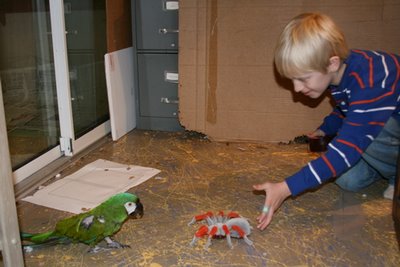 I found Charlie's nonchalance about a lifelike crawling spider as big as he is to be quite interesting. I'm going out on a limb here, but I think he can tell, better than Chet, whether or not an animated toy is actually alive. Birds, having a weak sense of smell, are more visually oriented than dogs, and he may well be able to see the wheels that propel it and draw conclusions from that and other clues mere dogs would miss. He isn't giving it the same reaction he gives to live insects, especially spiders and wasps. Watching one, he makes a characteristic rapid head shake, and he draws his nictitating membranes across his eyes as he does it. He was stung on the cheek by a yellowjacket about a decade ago, and the behavior may hearken back to that. (He was fine, but half his face swelled up like a walnut).
I found Charlie's nonchalance about a lifelike crawling spider as big as he is to be quite interesting. I'm going out on a limb here, but I think he can tell, better than Chet, whether or not an animated toy is actually alive. Birds, having a weak sense of smell, are more visually oriented than dogs, and he may well be able to see the wheels that propel it and draw conclusions from that and other clues mere dogs would miss. He isn't giving it the same reaction he gives to live insects, especially spiders and wasps. Watching one, he makes a characteristic rapid head shake, and he draws his nictitating membranes across his eyes as he does it. He was stung on the cheek by a yellowjacket about a decade ago, and the behavior may hearken back to that. (He was fine, but half his face swelled up like a walnut).No head shaking for the mechanical tarantula. Just mild curiosity.
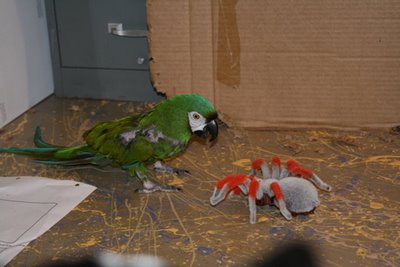 He followed it, tasted it, felt it, straddled it (Hmmm. About the right size for a partner!), thought about regurgitating a little breakfast for it, and then ended up grabbing it by the leg and throwing it a couple of times. At that point, we removed the tarantula.
He followed it, tasted it, felt it, straddled it (Hmmm. About the right size for a partner!), thought about regurgitating a little breakfast for it, and then ended up grabbing it by the leg and throwing it a couple of times. At that point, we removed the tarantula.One thing was sure: he didn't want the darn thing in his grotto, which is a recess behind a well-chewed piece of cardboard where he hides and plays with Chet.
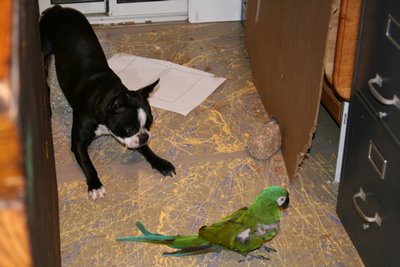 I originally set up the cardboard to keep him from chewing the cabinet door. His goal in chewing the door is to get inside the under-sink cabinet and set up housekeeping.
I originally set up the cardboard to keep him from chewing the cabinet door. His goal in chewing the door is to get inside the under-sink cabinet and set up housekeeping.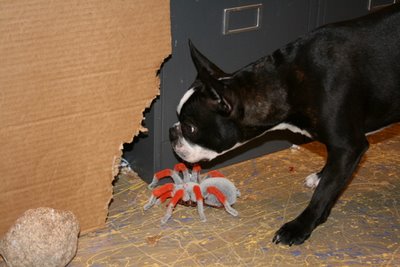 Baker plays hide-and-seek with Charlie, who mutters and laughs from his cave. Charlie? You in there?
Baker plays hide-and-seek with Charlie, who mutters and laughs from his cave. Charlie? You in there? 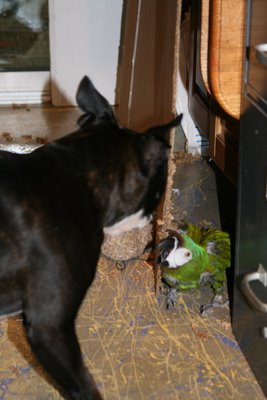 Boo! Mwoo ha ha ha! (He actually SAYS Mwoo ha ha ha!)
Boo! Mwoo ha ha ha! (He actually SAYS Mwoo ha ha ha!)It is the lot of captive parrots to be continually frustrated, which is part of what makes them challenging companions. They try their best to live out their biological imperative. This is a creature that mates for life, and spends all its time in the company of that mate. A captive parrot selects the only mate it can find find (in this case, me), but that mate, being inappropriately human, refuses to cooperate. I share my affections with another of my species, even when Charles viciously bites me to prevent my infidelity. I won't eat Charlie's regurgitated breakfast, no matter how tenderly proffered. Occasional furtive copulations with my sock-clad foot net him nothing but a temporary release. Despite his alluring displays of manly courage in pointing out and protecting his grotto, I won't crawl under the sink and lay two round white eggs that Charlie can incubate and protect.
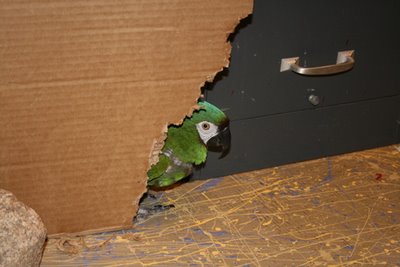 Come on in, baby. You know you're ovulating.
Come on in, baby. You know you're ovulating.But that doesn't keep him from trying to court me and carve out a nest hole, and he'll probably still be trying when he's 50. I had to get a dog to truly understand the difference between keeping a wild animal and calling it a pet, and having an animal around that is domesticated, truly selected to be a pet. If only we could breed a parrot's longevity into the otherwise perfect pet package of the dog. Forget putting glowing sea anemone genes into zebra danios, or carrot genes into cauliflower. Parrot longevity genes in Boston terriers: That's a bit of genetic manipulation I could get behind.
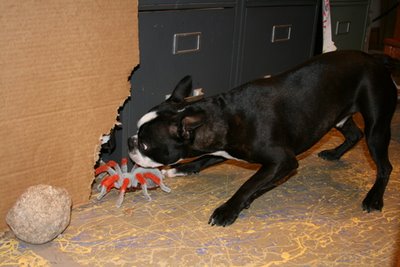






<< Home